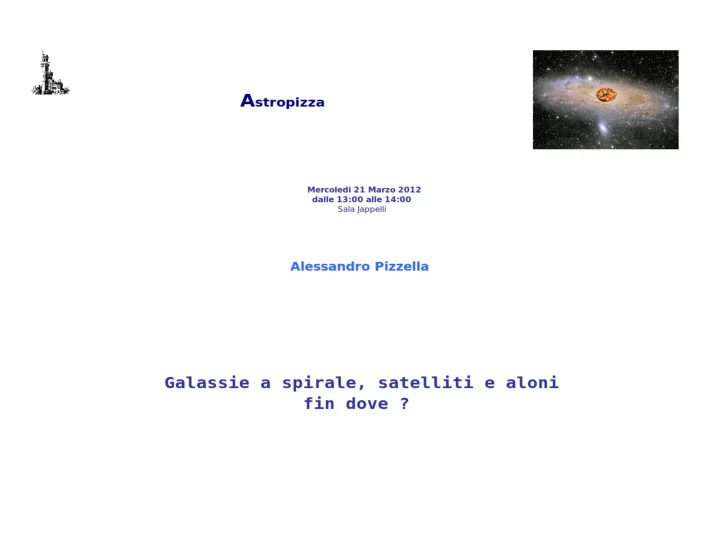

In collaboration with I. Yegorova and P. Salucci Outline: 1) description of the (pilot) project 2) observations 3) discussion
Dark Matter haloes extend far beyond the optical bonduaries of galaxies However, their actual “sizes” and their density distribution outside the luminous regions, are still quite unknown. Inner regions: Velocity dispersion (Ellipticals) Rotation Curves (Spirale) External regions: Planerary Nebule, Glubular clusters, weak lensing, satellites satellites
Satellites : can be used as test particles of the potential to probe the density profile and extent of the DM halo. Most studies use SDSS but this means to stack many galaxies each with few satellites (for instance, 4487 hosts and 7399 satellites with the SDSS/DR7 (Agustsson & Brainerd, 2010 and several other works) Our project was to use VIMOS+MOS to survey satellites around isolated galaxies with the idea of having as many satellites as possible for each host galaxy.
Pilot project: 8 galaxies Sample selection (1) late-type spirals; (2) 40◦ <i < 70◦; (3) no objects within a radius of 700 kpc and 1000 km/s in relative radial velocity with DM< 2.5 mag; (4) 0.029 < z < 0.085; (5) > 4 known satellites (from SDSS). Observations EMMI+NTT → long slit - rotation curve VIMOS+MOS → satellite hunt and radial velocity precise measurement
VIMOS ~45 hours; EMMI ~ 2 nights ~ 50 slit each quadrant x 4 quadrants = ~200 objects in each field 7 fields → ~1400 spectra (only one mask for each field)
J145211+044053 Z=0.046 r=14.62
Redshift found for ~600 galaxies
NTT+EMMI rotation curve H , [N II], and [S II] α
Some numbers about instruments VIMOS - 0.6 Å px−1 - Sky-lines to correct possible wavelength calibration snall offsets - Radial velocities from multiple lines and multiple exposures independently Typical redshift uncertainty less then 10km/s even for faint objects NTT – instrumental = 27 km/s at H . σ α Radial velocity from H , [N II], and [S II] α Carefull velocity curve folding to derive precise radial velocity (5km/s)
Discarding interlopers (Diaferio 1999)
(0) We can do it! We find satellites (down to M R = -16). We estimate ~ 15 satellites/galaxy (but we observed only half of them) (1) that the dark matter haloes of luminous spirals (MR −22) have virial radii of 400 kpc ∼ ∼ and virial masses of 3.5 × 10^12 Msun (2) that the radial velocity and angular distributions of the satellites around the primaries are Isotropic; (3) that the resulting mass distribution is in good agreement with that found in the optical regions of spirals extrapolated to large radii.
What we can do with the 500 remaining spectra?
Recommend
More recommend